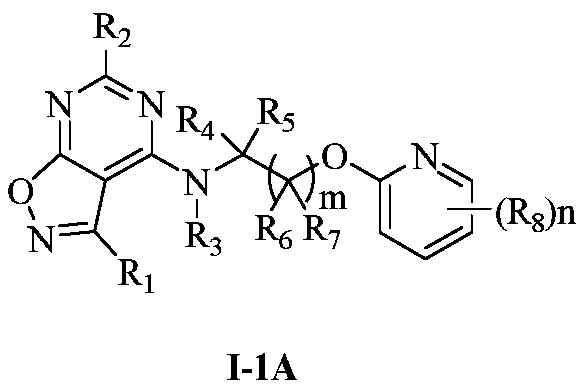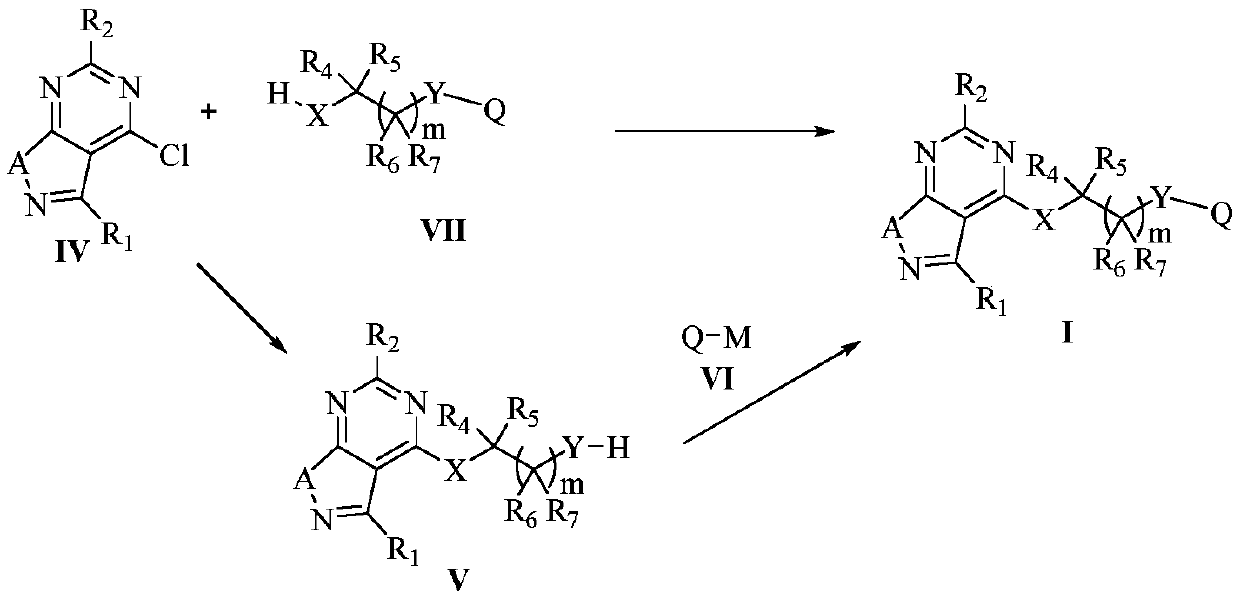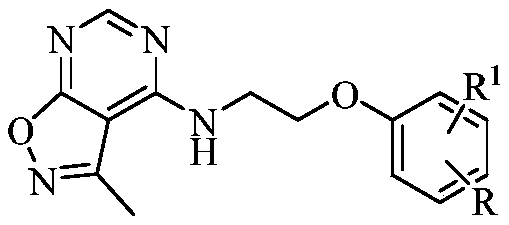Substituted six-membered heterocyclic compound containing pyrimido ring and its preparation method and use
A technology for six-membered heterocycles and compounds, which is applied in the field of substituted six-membered heterocycles containing pyrimido rings and their preparation, and can solve problems such as compounds that have not been reported
- Summary
- Abstract
- Description
- Claims
- Application Information
AI Technical Summary
Problems solved by technology
Method used
Image
Examples
Embodiment 1
[0354] Embodiment 1: Preparation of intermediate 2-((3-methylisoxazolo[5,4-d]pyrimidin-4-yl)amino)ethanol
[0355] 1) Preparation of 5-amino-3-methylisoxazole-4-cyano
[0356]
[0357] Dissolve 14g (0.2 mol) of hydroxylamine hydrochloride in 80mL of 10% sodium hydroxide, add 27.2g (0.2 mol) of (1-ethoxyethylene) malononitrile, add a small amount of ice to keep the temperature below 50°C, and continue at room temperature After stirring for 1.5 hours, the solid was filtered, washed with water, and recrystallized from absolute ethanol to obtain 16.5 g of a solid product.
[0358] 2) Preparation of 4-chloro-3-methylisoxazolo[5,4-d]pyrimidine
[0359]
[0360] Phosphorus oxychloride (POCl 3 ) 40mL and N,N-dimethylformamide 1mL were added to the reaction flask, stirred at room temperature for 1 hour, added 5-amino-3-methylisoxazole-4-cyano group (451mg, 3.66mmol), and heated to React at 160°C for 15-36 hours, and distill the reaction solution under reduced pressure to obtai...
Embodiment 2
[0364] Embodiment 2: the preparation of compound 7-33
[0365]
[0366] Add 0.16 g of 60% sodium hydride into the reaction flask, wash with petroleum ether, add 5 ml of N,N-dimethylformamide, and then add 2-((3-methylisoxazolo[5,4 -d] pyrimidin-4-yl)amino)ethanol 0.39g (2mmol), stirred at room temperature for 2 minutes, then added intermediate 2,3-dichloro-5-trifluoromethylpyridine 0.43g (2mmol), stirred at 60°C React for 2 hours. After the reaction was monitored by TLC, the reaction solution was poured into 50 ml of saturated brine, extracted three times with 100 ml of ethyl acetate, and dried. After precipitation, purification by column chromatography gave 0.36 g of an oily product, namely compound 7-33.
[0367] 1 H-NMR (300MHz, internal standard TMS, solvent CDCl 3 )δ(ppm):8.51(s,1H),8.34(s,1H),7.90(d,1H),5.83(s,1H),4.71(t,2H),4.16(q,2H),2.64( s, 3H).
[0368] Other compounds of the present invention can be prepared with reference to the above examples.
[0369] ...
Embodiment 3
[0379] Embodiment 3: Determination of bactericidal activity
[0380] The in vitro antibacterial activity or in vivo protective effect test is carried out on various fungal diseases of plants by using the compound sample of the present invention. See the following examples for the results of the bactericidal activity assay.
[0381] (1) Determination of in vitro bactericidal activity
[0382] The determination method is as follows: the high-throughput screening method is used, that is, the sample of the compound to be tested is dissolved in a suitable solvent (the type of solvent is such as acetone, methanol, DMF, etc., and is selected according to its dissolving ability for the sample), and the required concentration is prepared. Liquid to be tested. In an ultra-clean working environment, the liquid to be tested is added to the microwells of a 96-well culture plate, and then the suspension of pathogenic bacteria propagules is added to it, and the treated culture plate is pla...
PUM
 Login to View More
Login to View More Abstract
Description
Claims
Application Information
 Login to View More
Login to View More - R&D
- Intellectual Property
- Life Sciences
- Materials
- Tech Scout
- Unparalleled Data Quality
- Higher Quality Content
- 60% Fewer Hallucinations
Browse by: Latest US Patents, China's latest patents, Technical Efficacy Thesaurus, Application Domain, Technology Topic, Popular Technical Reports.
© 2025 PatSnap. All rights reserved.Legal|Privacy policy|Modern Slavery Act Transparency Statement|Sitemap|About US| Contact US: help@patsnap.com



